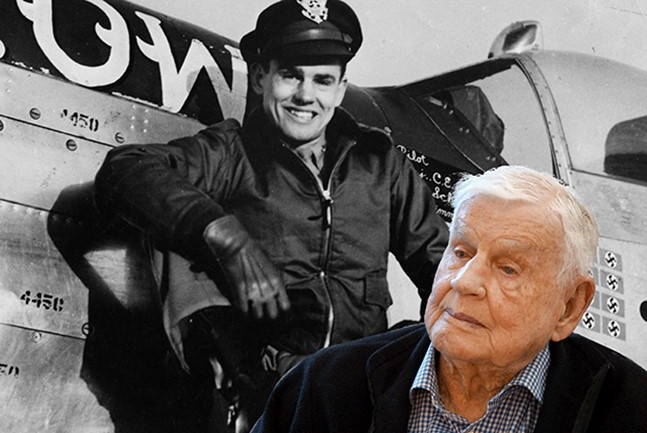Brig. Gen. Clarence E. “Bud” Anderson, the last surviving triple ace from World War II, a noted Air Force test pilot, and a 30-year veteran of the service who also flew combat missions during the Vietnam War, died May 17 at the age of 102.
Anderson shot down 16 German aircraft in WWII (and shared 1/4 credit on a 17th aircraft) in a variety of P-51 Mustangs he called “Old Crow,” after a preferred brand of whiskey. He logged more than 480 hours of combat time during the war, across 116 missions, all from March to December 1944, and all with the 363rd Fighter Squadron. The bulk of his kills were Focke-Wolfe 190s. He credited his especially keen eyesight as the key to his success, allowing him to spot enemy aircraft before they spotted him.
After the war, Anderson flew as a test pilot, logging time in more than 130 different types of aircraft, especially the “Century Series” of supersonic fighters, and he amassed more than 7,500 hours of flight time. After his retirement as a colonel, he worked for the McDonnell Aircraft Co. as its chief of flight test.
Anderson grew up near Sacramento, Calif., and earned his pilot’s license while still a teenager. He joined the Army as an aviation cadet shortly after the Japanese attack on Pearl Harbor and earned his wings before the end of 1942. He trained in the P-39 Airacobra, which he flew at several stateside bases, but switched to the P-51 soon after arriving in Europe in late 1943.
By early 1944, as part of the 357th Flying Group—self-nicknamed “The Yoxford Boys”—Anderson was flying escort for bombers over Europe. Only a month after starting escort missions, he downed his first German aircraft, a Messerschmitt BF-109. By the end of May, he had become an ace, meaning he had shot down five enemy aircraft. In June, he shot down three FW-190s in a single day, and by the end of that month had become a double ace.
After taking stateside leave, he returned to flying duty and in November and December 1944 shot down three FW-190s and forced down one more, his final aerial victories, making him the 357th’s third-leading ace, with 16.25 kills. None of the planes Anderson flew were hit by enemy fire and he never aborted a mission.
Back in the states, the Air Force deployed the high-scoring ace as a goodwill ambassador and recruiter, but by 1948 he returned to regular flying as a test pilot at Wright Field, Ohio, where he served until 1953, working on a variety of experimental projects. Among the concepts he tested was the F-84 as a parasite fighter operating off a B-36 bomber.
After Air Command and Staff College, he was assigned as director of operations at the 58th Fighter-Bomber Wing at Osan Air Base, Korea, from August 1955 to February 1956, when he took command of the 69th Fighter-Bomber Squadron at Osan until August 1956.
From there he went to Edwards Air Force Base, Calif., where he became Chief of Test Flight Operations until 1962, flying or supervising test on a wide variety of jet aircraft, including the first double-sonic jets.
He completed the Army War College and several operational assignments after that, until he was assigned to command the 18th Tactical Fighter Wing at Kadena Air Base, Japan until late 1967.
After a Pentagon tour, Anderson commanded the 355th Tactical Fighter Wing from June to December 1970, flying 25 combat missions against the Ho Chi Minh Trail from Takhli Royal Thai Air Force Base. He was in charge of closing the base when it deactivated.
Anderson retired in 1972, having been decorated with two awards of the Legion of Merit, five awards of the Distinguished Flying Cross, the Bronze Star, and 16 Air Medals, as well as the French Legion of Honor and Croix de Guerre. After retirement, he managed McDonnell’s flight test operations at Edwards until 1998, where he supervised test projects such as the F-15 Eagle, F/A-18 Hornet, and C-17 Globemaster III.
In 1990, Anderson cowrote “To Fly and Fight – Memoirs of a Triple Ace,” which was updated and re-published in 2019. In the book, Anderson’s lifelong friend and fellow ace and test pilot Chuck Yeager described him as “the best fighter pilot I’ve ever seen.”
Also in 2019, the Smithsonian’s Air & Space Museum unveiled a special display of Anderson’s flight jacket and flying gear as a highlight of the World War II display at its Udvar-Hazy Center. The same day, he recorded recollections of some of his service history with Air & Space Forces Magazine.
He was given an honorary promotion to brigadier general in December 2022, in a ceremony at the Aerospace Museum of California, near his boyhood home, presided over by then-Chief of Staff (now Joint Chiefs of Staff Chairman) Gen. Charles Q. Brown Jr.
Anderson was inducted into the National Aviation Hall of Fame in 2008 and the International Air & Space Hall of Fame in 2013. In 2015, along with other American Fighter Aces, he received the Congressional Gold Medal, and in 2017, received the Air Force Association’s Lifetime Achievement Award.
A life-size bronze statue of Anderson stands at the Auburn Municipal Airport in California, near his hometown of New Castle. He was a life member of the American Fighter Aces Association and was a Fellow of the Society of Experimental Test Pilots.
